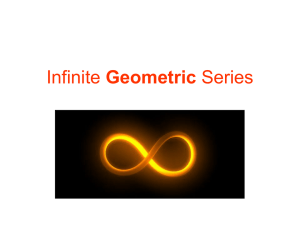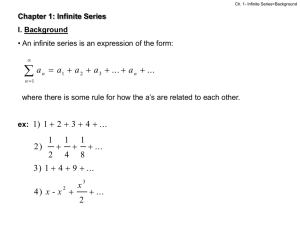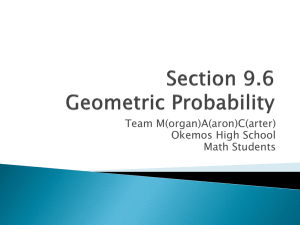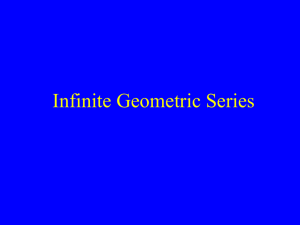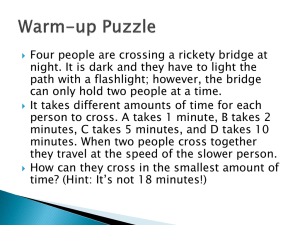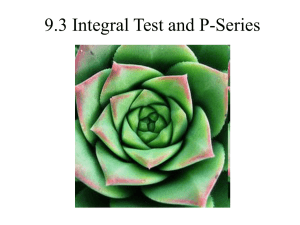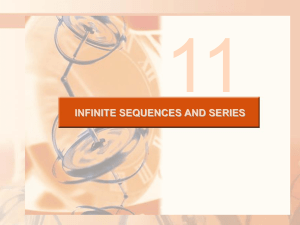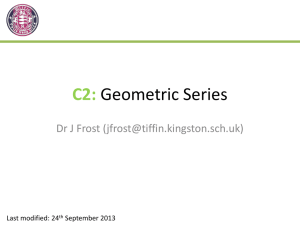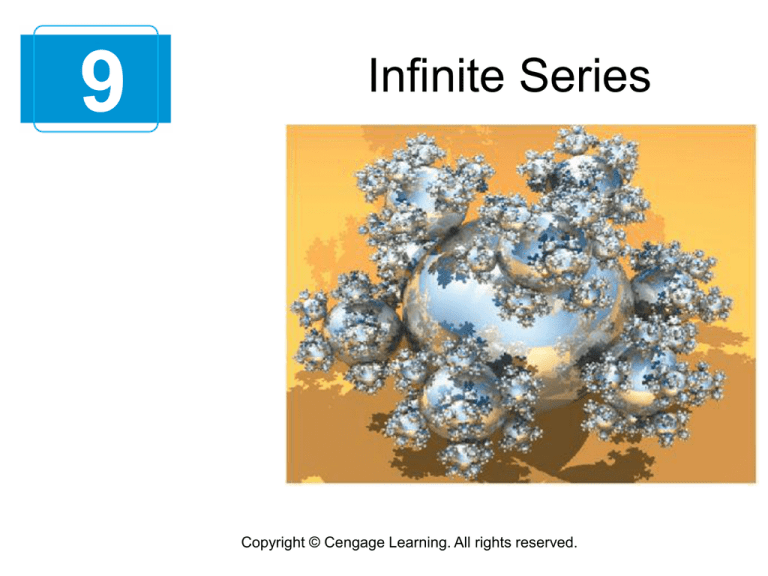
9
Infinite Series
Copyright © Cengage Learning. All rights reserved.
9.2
Series and Convergence
Copyright © Cengage Learning. All rights reserved.
Objectives
Understand the definition of a convergent
infinite series.
Use properties of infinite geometric series.
Use the nth-Term Test for Divergence of an
infinite series.
3
Infinite Series
One important application of infinite sequences is in
representing “infinite summations.”
Informally, if {an} is an infinite sequence, then
is an infinite series (or simply a series).
The numbers a1, a2, a3, are the terms of the series. For
some series it is convenient to begin the index at n = 0
(or some other integer). As a typesetting convention, it is
common to represent an infinite series as simply
4
Infinite Series
In such cases, the starting value for the index must be
taken from the context of the statement.
To find the sum of an infinite series, consider the following
sequence of partial sums.
If this sequence of partial sums converges, the series is
said to converge.
5
Infinite Series
6
Example 1(a) – Convergent and Divergent Series
The series
has the following partial sums.
The sequence of partial sums
7
Example 1(a) – Convergent and Divergent Seriescont’d
Because
it follows that the series converges and its sum is 1.
8
Example 1(b) – Convergent and Divergent Seriescont’d
The nth partial sum of the series
is given by
Because the limit of Sn is 1, the series converges and its
sum is 1.
9
Example 1(c) – Convergent and Divergent Seriescont’d
The series
diverges because Sn = n and the sequence of partial sums
diverges.
10
Infinite Series
The series
is a telescoping series of the form
Note that b2 is canceled by the second term, b3 is canceled
by the third term, and so on.
The nth partial sum of this series is Sn = b1 – bn + 1
11
Infinite Series
Because the nth partial sum of this series is
Sn = b1 – bn + 1
it follows that a telescoping series will converge if and
only if bn approaches a finite number as
Moreover, if the series converges, its sum is
Because the limit of Sn = 1, the series converges and its sum is 1.
12
Example 2: Writing a series in Telescoping Form.
Find the sum of the series:
4n
n 1
2
2
1
Using partial fractions:
2
2
1
1
an 2
4n 1 2n 1 2n 1 2n 1 2n 1
From this form, the nth partial sum is:
1
1 1 1 1
sn ... 1
2n 1
1 3 3 5
So the series converges and its sum is 1.
13
Ex: Find the sum:
All the fractions cancel except the first ones in the 2
leading terms and the last 2 in the last two terms.
14
Geometric Series
15
Geometric Series
The series
series.
is a geometric
In general, the series given by
is a geometric series with ratio r.
16
Geometric Series
17
Example 3(a) – Convergent and Divergent Geometric Series
The geometric series
has a ratio of
with a = 3.
Because 0 < |r| < 1, the series converges and its sum is
18
Example 3(b) – Convergent and Divergent Geometric Series
cont’d
The geometric series
has a ratio of
Because |r| ≥ 1, the series diverges.
19
Ex. #4
Use a geometric series to find the sum of the repeating
decimal 0.08 .
.080808…=.080000+.0008+.000008+…
8
8
8
8
2 4 6 8 ...
10 10 10 10
8 1
0.08 2 2
n 0 10 10
8
Infinite geometric sum =
99
n
20
Ex:
Use a geometric series to find the sum of the
repeating decimal 0.337733773377…
0.337733773377… = .3377 + .00003377 + .000000003377 +…
This is a geometric series where r = .0001 < 1.
21
Ex: Find all values of x
for which the series converges.
Write the sum of the
series as a function of x.
#81
22
nth-Term Test for Divergence
24
nth-Term Test for Divergence
If a series converges, the limit of its nth term must be 0.
Careful: The converse is not true, just because the nth term is zero,
doesn’t mean the series converged!
The contrapositive of Theorem 9.8 provides a useful test for
divergence. This nth-Term Test for Divergence states that if the limit
of the nth term of a series does not converge to 0, the series must
diverge.
25
Example 5 – Using the nth-Term Test for Divergence
a. For the series
you have
So, the limit of the nth term is not 0, and the series
diverges.
b. For the series
you have
So, the limit of the nth term is not 0, and the series
diverges.
26
Example 5 – Using the nth-Term Test for Divergence
c. For the series
cont’d
you have
Because the limit of the nth term is 0, the nth-Term Test
for Divergence does not apply and you can draw no
conclusions about convergence or divergence.
27
Two Theorems
As we progress through this chapter, we will become more
interested in whether or not a given series converges than in
the actual sum itself. Actual sums can be left to computers.
28
Ex: #
Assume
NOT…
(proof by
contradiction)
Q.E.D.
29
However, surprisingly, the converse is NOT true.
Example:
However,
Be verrrry careful
when you mess with
infinity!
I’m so scared
that I think I’ll do
ALL my
homework
tonight!
30
Σ1/n is called the Harmonic Series. Terms
after the first two are the harmonic means
of those on either side. (Harmonic mean is
the reciprocal of the mean of the
reciprocals).
31
About the divergence of Σ1/n. Don’t confuse the sequence
{1/n} with the series Σ1/n.
The sequence {1/n} does converge. As n approaches infinity,
then 1/n approaches 0.
The series Σ1/n means something different.
It means 1 + 1/2 + 1/3 + 1/4 + 1/5 + ...
So in the series Σ1/n, intuitively you are adding up things
which eventually get small, but you are adding up infinitely
many of them, which can yield something large.
The following is one way to see how Σ1/n diverges.
32
If you group the series Σ1/n like this:
(1) + (1/2) + (1/3 + 1/4) + (1/5 + 1/6 + 1/7 + 1/8) + (1/9 + 1/10 + 1/11 + 1/12
+ 1/13 + 1/14 + 1/15 + 1/16) + ...
Then the first parenthesized expression has value 1.
The second parenthesized expression has value 1/2.
The third parenthesized expression has value greater than 2/4, because
there are 2 fractions and all are at least as large as 1/4.
The fourth parenthesized expression has value greater than 4/8, because
there are 4 fractions and all are at least as large as 1/8.
The fifth parenthesized expression has value greater than 8/16, because
there are 8 fractions and all are at least as large as 1/16.
By continuing in this manner, you can view the series Σ1/n as the sum of
infinitely many "groupings," all with value greater than 1/2. So the series
diverges, because if you add up 1/2 enough times, the sum will eventually
get as large as you like. Therefore, Σ1/n diverges.
33
Writing Assignment:
Explain the difference between what it
means for a sequence to converge or a
series to converge.
34
Homework Section 9.2
Day 1: pg. 612 #1-33 odd
Day 2: pg. 612 #35-71 odd
35
Integral test for divergence of the
harmonic series.
https://www.youtube.com/watch?v=TODKCEjmN_4
36

